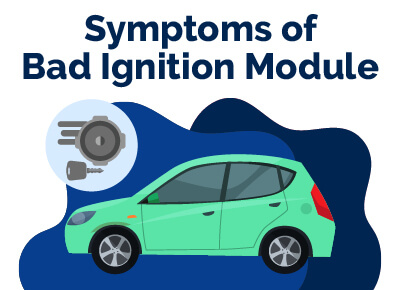Top 7 Symptoms of Bad Ignition Module
January 31, 2023


I am a serial entrepreneur and a consumer advocate. When I’m not helping car buyers, I love working on ventures that have a positive impact.
I run a cause marketing agency and serve on the board of Vayu Global Health where we are disrupting the medical industry and preventing the needless deaths of mothers and babies during childbirth.
The ignition system is also very important in properly operating a vehicle. Each of its components is responsible for producing the required voltage for the spark plugs.
Many older cars have a stand-alone control module, while modern cars are designed to switch on and off ignition coils. With the proper ignition control module, the engine will run properly.
In this article, we will discuss the various symptoms of bad ignition modules, how to fix a bad ignition module and exactly what it costs to replace an ignition module.
Let’s get started!
Table of Contents
What is an Ignition Module?
An internal combustion engine has a control module responsible for controlling the amount of spark produced.
This component usually operates by opening or closing a ground circuit to the primary winding of the ignition coils.
This process ensures that the ignition coils produce enough voltage to light up a spark plug. The control module then receives a signal from the distributor to ground the coils.
Some ignition modules are equipped with insulating materials to protect the internal components. These are usually found inside or near the distributor.
In most modern vehicles, the ignition coils' primary winding is grounded through the distributor's contact points.
When the distributor shaft spins, the points open and break the circuit, leading to the circuit's primary magnetic field collapsing.
This leads to the production of a high voltage. Electronic ignitions then replace the points' function.
Symptoms of Bad Ignition Module
The ignition module is the heart of an automobile's ignition system. Like other components, it will eventually wear out and break eventually.
However, recognizing the warning signs of a bad ignition module can prevent it from happening in the first place.
1. Overheating
If the ignition module gets too hot, it will eventually stop working and cause various problems, such as engine stuttering, electrical shorts, and gasoline odor in the exhaust.
The temperature must be checked while the car is running to avoid this.
If the vehicle stalls, it's possible that the ignition control is the cause of the issue. Try cooling the car using a coolant or ice water to prevent this.
This will only be a temporary solution until the vehicle's ignition components are fixed.
2. Difficulty in Starting
A no-spark condition is one of the most common symptoms of this issue. In most cars, fuel, exhaust, spark, and compression are the four inputs needed to start and drive properly.
If the ignition control fails, it will eventually mix with the other inputs and cause problems. A total failure of the ignition module will prevent the car from starting.
The ignition will still work if you hear clicking sounds while trying to start the car.
But if the vehicle's control module is defective, it won't generate power and will prevent combustion.
3. Rough Engine
Partial combustion is a common symptom of engine misfires. If the igniter fails, it can compromise the spark, leading to various issues, such as loss of power and performance problems.
If the fuel mixture cannot ignite properly, this issue will most likely happen while you're driving.
If your vehicle has many defective ignition coils, you might experience difficulty starting the engine.
Other issues, such as a flat battery, can cause difficult-to-start engines.
4. Acceleration Issues
If the vehicle's acceleration is not smooth, it might be caused by a defective spark plug.
The ignition might need help to create the spark to start the vehicle. The vehicle might vibrate, shake, or sputter when the gas pedal is pressed.
If the vehicle produces less power, it will also not start. Bad injectors can cause this. Having the wires and plugs replaced can help solve this issue.
5. Check Engine Light Will Turn On
The illuminated check engine light is another symptom of an ignition issue. This is because the light will come on whenever something goes wrong in the vehicle.
This light might come on because of issues related to the ignitor's performance.
You can use an onboard scan tool to check for the error code if your vehicle has an issue with its engine.
The possible DTCs for this issue are p0300 and p0312. If you don't have a diagnostic tool, you should take your vehicle to the mechanic to fix it.
6. Excessive Fuel Consumption
If your vehicle's mileage is getting less than usual after a full fuel tank, it could be a faulty ignition control module.
If this is the case, the system will try to replace the underpowered spark plugs by injecting more fuel which might lead to increased fuel usage.
This suggests that a fuel leak might indicate a faulty ignition switch. However, it's important to rule out potential problems such as a dirty engine filter or a faulty mass air flow sensor.
7. Black Smoke from Exhaust
Dark exhaust fumes from your car's exhaust might be related to the issue with your vehicle's ignition control module. A bad control module could cause your car's engine to misfire.
When your vehicle has a misfire, the excess fuel left in the cylinders gets sent to the catalytic converter, turning it into pollutants.
The excess fuel could also damage the catalytic converter over time. This could indicate that your vehicle's ignition control module is defective.
Ignition Module Test
A vehicle's control module is responsible for controlling the ignition system's solid-state "On/Off" switch. A sensor inside the distributor relays a signal to the module.
The ignition module is powered by the signal it receives to supply the energy for the spark plugs. It can be placed on the side of the engine or inside the distributor.
The engine will typically only run when the ignition module is working properly. The easiest way to check this issue is by following these simple steps:
1. After removing one of the wires from the spark plug, a used spark plug can be inserted into the boot of the engine. The metal surface of the engine should have a spark plug.
After you have turned the engine on, inspect the old plug for a spark. If there is no spark, this issue might be related to an issue with the ignition module.
2. Check the voltage at the positive and negative terminals of the ignition coils. The red lead from the multimeter should be placed on the positive terminal, while the black lead should be on the negative one.
Check the voltage at the battery's positive terminal. If the voltage is not present, the ignition switch or the wire circuit might be at fault.
3. The red lead from the multimeter should be placed on the positive terminal, while the black lead should be on the negative one. Check the positive (+) wire of the ignition module.
The voltage at the wire connecting the battery to the ignition switch should be measured. If the voltage is not present, an open circuit should be found between the wires.
4. Check the negative wire of the ignition module using the multimeter's red lead. You can disconnect the wires from the spark plug to remove the distributor cover.
The engine should be turned over, or the distributor center shaft should be turned by hand. As the vehicle goes over, inspect the rotor.
If the distributor's rotor can't turn, it might be related to an issue with the distributor's gears. Check the multimeter's voltage level by alternating between zero and the battery voltage.
5. The readings from the multimeter might stay the same if the distributor's voltage goes from zero to positive. This issue might require replacing the ignition module.
Check the location of the distributor cap. It would be best if you also disconnected the ignition module and the battery from the multimeter.
How Much Does an Ignition Control Module Replacement Cost?
Replacing an ignition control module can range from $50 to $250. Labor costs can also be higher, at up to $90. These are only estimates, so you might have to factor in other expenses.
How Do You Fix a Bad Ignition Control Module?
One of the advantages of having an ignition control module is that it can be easily fixed.
This is because it's a component of an anti-theft system in some cars. Replacement can be done by taking your vehicle to a dealer or repair shop.
Doing this will involve deactivating the steering column, which could cause an airbag deployment if it's not working properly.
The level of difficulty when it comes to fixing an ICM issue varies depending on the make and model of your vehicle.
Having your car inspected by a mechanic can help identify the symptoms of an issue with the control module.
Before you start working on replacing the control module, make sure that you have the necessary skills to do the job properly. This will allow you to avoid introducing other problems to the process.
Best Car Deals by Category
Posted in Car Buying Tips, Car Troubleshooting |




